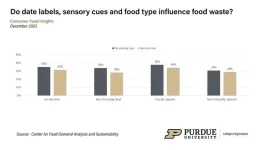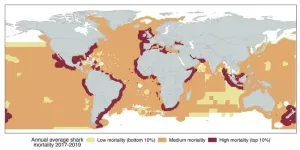(Press-News.org)
The world is filled with a myriad of sounds and vibrations—the gentle tones of a piano drifting down the hall, the relaxing purr of a cat laying on your chest, the annoying hum of the office lights. Imagine being able to selectively tune out noises of a certain frequency. Researchers at the University of Illinois Urbana-Champaign have synthesized polymer networks with two distinct architectures and crosslink points capable of dynamically exchanging polymer strands to understand how the network connectivity and bond exchange mechanisms govern the overall damping behavior of the network. The incorporation of dynamic bonds into the polymer network demonstrates excellent damping of sound and vibrations at well-defined frequencies.
“This research is about using polymers to absorb various sounds and vibrations that can occur at different frequencies,” says materials science and engineering professor Chris Evans, who led this work. “We want to know how to design the molecular-scale chemistry of the polymer in such a way that we control what sort of energy absorbing ability it has.”
The results of this new research were recently published in Nature Communications.
Being able to tailor polymers to absorb specific frequencies can be beneficial for use in ear plugs and helmets for people near blasts or explosions and in scenarios with repeat exposure to a certain frequency of noise, like a helicopter pilot, where such long-term exposure can lead to hearing problems.
Polymers are long chain molecules composed of many repeating units. Some polymers are not fully linear and have branches, like trees, and other polymers are highly cross-linked where individual polymer chains are connected by covalent bonds to other chains, like a net. The cross-link point is a bond that links one polymer chain to another, and this is where bonds can exchange.
Dynamic bonds within a polymer network allows it to rearrange its structure in response to a change in environment (high temperature, pH, UV light exposure, etc.). Replacing a few covalent bonds in cross-linked polymer structures with dynamic bonds can enhance the properties of the polymer such as the modulus—the stiffness of the material—and the viscosity—how easily the material flows. Dynamic bonds provide materials with unique properties such as self-healing, super-stretchability, adhesive properties and material toughness due to the modification of the viscoelastic properties.
“The key advance here is that we’re using dynamic covalent bonds,” Evans explains. “They’re chemical bonds but they can exchange with each other (the dynamic part) and when two different chemistries are used; they can exchange at very different timescales (the orthogonal part). We’re using that process to try and control what frequencies of sound and vibration we’re absorbing.”
Incorporating orthogonal bonds, where fast bonds can only exchange with other fast bonds and slow bonds can only exchange with other slow bonds, generates multiple and well-separated relaxation modes, which gives the network excellent damping and improved mechanical properties, like toughness.
The team made a series of polymers that had controlled types of architectures and backbones and they looked at the way that the polymer chains are connected. Evans says that it actually makes a big difference how the polymer chains are connected in order to get the energy dissipating processes at very specific timescales that would correspond to very specific sound waves or vibrations. If the chains are only linked at the ends, this is not as effective as being linked periodically along the chain backbone.
One of the main limitations with the materials used in this research, however, is that they do ultimately flow. For example, rubber bands will retain their shape, but when those dynamic bonds are added in, they’ll always eventually flow, like silly putty. This is fine for, say, a soldier’s helmet where the material is enclosed within the shell of the helmet, but not so much for an ear plug. Evans says his group is working on ways to get the polymer to be more of a self-standing material, and in the future, they’d like to incorporate more dynamic bonds, so the polymer isn’t just tailored for a specific frequency, but for a much wider range of frequencies.
*
Chris Evans is also an affiliate of the Materials Research Laboratory and the Beckman Institute for Advanced Science and Technology at UIUC.
Other contributors to this work include Sirui Ge (department of materials science and engineering and the Materials Research Laboratory at UIUC) and Yu-Hsuan Tsao (department of materials science and engineering and the Materials Research Laboratory at UIUC).
This research was funded by the Air Force Office of Scientific Research and the National Science Foundation.
END
WEST LAFAYETTE, Ind. — Building off the previous month’s survey, the December 2023 Consumer Food Insights Report digs deeper into the relationships between food-date labels and the decision to discard food. The report also explores generational differences in food behaviors and reviews 2023 trends for out-of-stock items and common foods that people reported limiting in their diets over the year.
The survey-based report out of Purdue University’s Center for Food Demand Analysis and Sustainability assesses food spending, consumer satisfaction and values, support ...
HOUSTON, January 10, 2024 – Mike Norvell, head coach at Florida State University, was named college football Coach of the Year at the American Heart Association’s Paul “Bear” Bryant Awards, presented by Marathon Oil. The 38th annual awards program benefits the American Heart Association, the world’s leading voluntary health organization devoted to a world of longer, healthier lives for all.
In his fourth season as the head coach at Florida State, Norvell led the Seminoles to a 13-1 overall record and an 8-0 mark in the Atlantic Coast Conference (ACC). Norvell was previously honored as the ACC Coach of the Year and was ...
Wastewater surveillance is a potent tool in understanding COVID-19 transmission within school settings, according to a ground-breaking study led by epidemiologist David Larsen from Syracuse University.
The research team’s work that was published recently in PLOS Global Public Health establishes the pivotal role of wastewater analysis in managing the public health response to COVID-19 at schools.
The study focused on a middle and high school campus in Jefferson County, New York, serving 600 students and compared results from wastewater surveillance to COVID-19 case trends. The surveillance ...
New UC Davis research shows that men with an FMR1 premutation who experienced reduced executive function were at higher likelihood of developing fragile X-associated tremor/ataxia syndrome (FXTAS).
FXTAS is a progressive genetic condition that causes movement issues and cognitive decline. These findings, published in the journal Movement Disorders, could help clinicians determine which premutation carriers will eventually develop FXTAS.
“There's converging evidence that the premutation is affecting certain circuits in the brain ...
Human activity, from burning fossil fuels and fireplaces to the contaminated dust produced by mining, alters Earth’s atmosphere in countless ways. Records of these impacts over time are preserved in everlasting polar ice that serves as a sort of time capsule, allowing scientists and historians to link Earth’s history with that of human societies. In a new study, ice cores from Antartica show that lead and other toxic heavy metals linked to mining activities polluted the Southern Hemisphere as early as the 13th century.
“Seeing evidence that early Andean ...
Images
An insight into preventing perovskite semiconductors from degrading quickly, discovered at the University of Michigan, could help enable solar cells estimated to be two to four times cheaper than today's thin-film solar panels.
Perovskites may also be combined with the silicon-based semiconductors that are prevalent in today's solar panels to create "tandem" solar cells that could surpass the maximum theoretical efficiency of silicon solar cells.
"Silicon solar cells are great because they are very efficient and can last for a very long time, but the high efficiency comes with a high cost," ...
Sharks have persisted as powerful ocean predators for more than 400 million years. They survived five mass extinctions, diversifying into an amazing variety of forms and lifestyles. But this ancient lineage is now among the world's most threatened species groups due to overexploitation in poorly regulated fisheries and the proliferation of wasteful finning practices.
Governments around the world have introduced a host of regulations aimed at reducing shark catch and finning, the latter of which typically sees valuable shark fins retained for sale while carcasses are discarded at sea. But until ...
A dense system of pre-Hispanic urban centers, characterized by constructed platforms and plazas and connected by large, straight roads, has been discovered in the upper Amazon, according to a new study. The research, based on more than 20 years of interdisciplinary research, suggests that this original 2500-year-old society constitutes the earliest and largest low-density agrarian urbanism documented in the Amazon thus far. Such extensive early development in the Upper Amazon resembles similar Maya urban systems in Central America. ...
Clinical prediction models for schizophrenia treatment outcomes that work well within the trials from which they were developed fail to generalize to future trials, according to a new study. “The findings not only highlight the necessity for more stringent methodological standards for machine learning approaches but also require reexamination of the practical challenges that precision medicine is facing,” writes Frederike Petzschner in a related Perspective. Despite receiving the same treatments for the same afflictions, some patients get better while others show no improvement. Precision medicine approaches seek to address this problem by providing tailored treatments for individual ...
Despite widespread legislation and fishing regulations aimed at reducing wasteful shark finning practices, global shark fishing mortality is still on the rise, researchers report. The findings suggest that improved regulations are needed to reverse the continued overexploitation of these species. Over the last several decades, sharks have been increasingly recognized as some of the planet’s most threatened wildlife. Increasing shark mortality has been driven in part by overfishing – large numbers of sharks are often captured as bycatch in tuna ...





